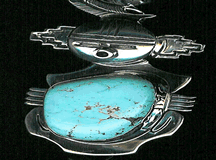American Indian Jewelry
American Indian's have several different types of handcrafted jewelry. The differences between the jewelry that the American Indian's made and the ones other countries made is that the American Indian jewelry had less markings on them. They used beads, shells, copper and silver, ivory, amber, turquoise and other stones to make their jewelry. American Indian's knew how to make jewelry even before the Europeans came to America. The Native American jewelry makings traditions stays strong, incorporating rather than being replaced by new materials and techniques like glass beads and metalworking which was more advanced. The two general categories of Native American jewelry is metal work and bead work. Before the Europeans came to America jewelry making for the Natives was pretty easy, all they had to do was hammer and etch copper into a pendant or earring and fashioning copper and silver into the beads.
The most impressive traditional jewelry from the Native Americans belonged to the Navajo, Hopi, Zuni, and Pueblo tribes. There are plain Indian beaded work that is used as necklaces. Beads were a common trade item since ancient times, so it was not surprising to see different tribes jewelry in other tribes hands. This was going on even before the Europeans came and forced everyone onto reservations near each other. The way they made their jewelry was that they soaked a piece of a porcupine quill and the intricate stitching of thousands of beads together. Porcupine quill work has nearly died out. Most handmade jewelry that is made by the Native America's is really expensive because it is rare to find. If you want to get Native American jewelry that is pretty reasonably priced then you should look into getting earrings. There is also a thriving trade among collectors for something called “old pawn” or “dead pawn” Indian jewelry. This is an antique jewelry which was pawned by Navajo and other Southwest Indians in such desperate financial straits that they were never able to reclaim them. The jewelry that is referred to today as Native American jewelry, southwestern jewelry and Indian jewelry is closely associated with the use of turquoise. This stone is generally found in mineral deposits in the southwestern part of the United States. Turquoise can also be found in western South America. This is how Native Americans and South America got the color turquoise.
By the 1890s, traders took advantage of the new market with silversmiths and began selling tools and silver slugs.
Soon, the Harvey Company was commissioning Indian-style machine-made jewelry. Indians may or may not have been employed for the handwork on these assembly-line pieces. Other manufacturers followed, producing earrings, bracelets, rings, brooches, pins, money clips, commemorative spoons and other trinkets. Collectors of this souvenir jewelry--often called "Harvey House" or "workshop jewelry"--look for its machined-tooled precision and uniformity, affectation of an Indian style, and relative delicate lines. The pieces were generally small, sized to sell cheaply. Turquoise, when used, was treated or coated to harden and enhance color. Designs were usually stamped, and common motifs were thunder birds, lightning, and bows and arrows.
The differences between authentic and imitation silver work are subtle, a condition exacerbated by the tendency of smiths to copy what is the most successful or profitable, and to lower their standards for tourists who are often looking for cheap mementos.
HOME
Indian Handcrafted Jewelry
African Jewelry
Middle Eastern Jewelry
Spanish Jewelry
American Indian Jewelry
SITE MAP

